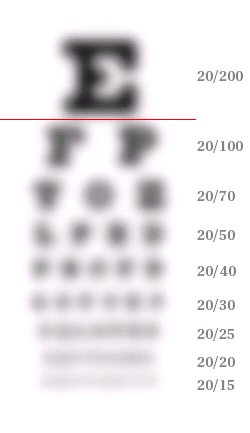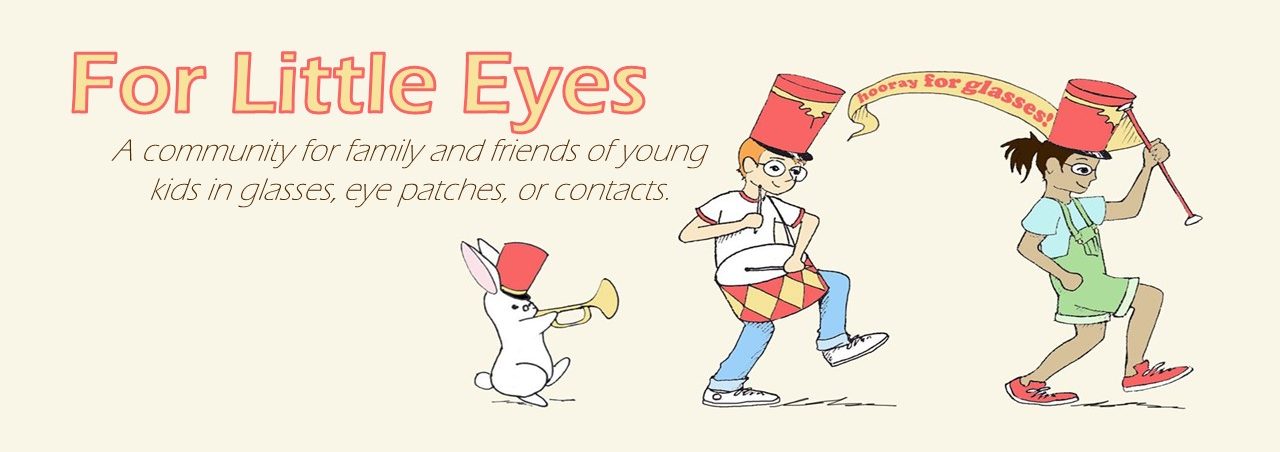There’s a cliche of “looking through your eyes” as a way of trying to see the world as someone else might. It’s usually not meant literally, of course, but it reflects our desire to understand how others see things. That’s certainly true when you learn that your child has a vision problem. It’s very common to wonder how your child had been seeing.
Very young children don’t have the words to tell us what they want for dinner, let alone how they see. Even older, more verbal kids have difficulty explaining how things look. It wasn’t until Zoe was 4 that she started telling me that things were fuzzy without her glasses. But the first time I really understood how she saw was after a trip to the science museum where she visited a human development exhibit. They had glasses you could put on that approximated how babies’ vision develops in their first few months. “Mom, babies see really blurry they’re first month. Then at 2 months, they see the way I see without my glasses. By a year, they see how I see with glasses.” Finally, I could put on glasses and see the world the way Zoe does without her glasses.
If you can’t make it to a human development exhibit, there are quite a few online vision simulators that claim to let you see how another person sees, most are based on a person’s glasses prescription. Of course, there are a lot of problems with even the best of these. In fact:
A glasses prescription will not tell you exactly how a person sees
Similar to how a drug prescription will not tell you everything about how a person functions without those drugs, a glasses prescription can’t tell you everything about how a person sees without their glasses. A glasses prescription will tell you what shape the lenses on a pair of glasses or contacts should be in order to have the best possible corrected vision. This is based on how much the shape of the eye differs from what it should be to see clearly (something called the refractive error). Some (not all) of the reasons why someone may see differently than their glasses prescription implies include:
- Hyperopic children can often compensate for much of their hyperopia, allowing them to see relatively clearly. This does cause eye strain and can pull the eyes out of alignment, which is why glasses are still important.
- Amblyopia is when a person does not see clearly even when glasses or contacts are correcting for the full refractive error. Generally this is due to the brain suppressing the vision from one or both eyes. It can be caused by the eyes not lining up, an eye having an injury, or one eye having a much stronger refractive error than the other.
- There may be other problems in the visual system (either in the eye structures, the optic nerve, or the brain) that is causing vision problems.
One very simplified way of looking at it is imagining the visual system as a camera. The lens of the camera may not be in focus, that’s the part that glasses can fix that. But there are a lot of other components of the camera that may not be functioning correctly, and any one of them can lead to unclear vision.
Visual Acuity
The measurement that best describes how clearly a person sees is their visual acuity. It is usually expressed as two numbers, like 20/20 or 6/6. The first number tells you the distance at which the measurement was taken (20 or 10 is in feet, 6 or 3 is in meters). The second number tells you how far away a person with good vision could be to see what you see clearly.
For example, the visual acuity of my left eye without glasses is around 20/200. That means that what I see clearly at 20 feet away, a person with good vision would see clearly at 200 feet away. (I do not see terribly well in that eye). There’s a conversion chart here that converts between metric and US measurements as well as giving reading performance for those acuities.
If you’d like to see what a specific visual acuity looks like, there are a couple of options:
Wolfram Alpha will show you a simulation of any acuity you type in. Simply type in the visual acuity with the word “vision”: in this case “20/200 vision” (if you don’t include the word “vision” it’ll just calculate the fraction for you).

Wolfram Alpha’s simulation of 20/200 visual acuity. I typed “20/200 vision” in the search box to get this.
Fork in the Road Low Vision Simulators are vision simulators that you can purchase and wear to see the effects of different eye diseases. Their cataract simulators demonstrate reduced visual acuity. On their website, you can see examples of the blur simulation for 20/80 (6/24), 20/200 (6/60), 20/400 (6/120), and 20/800 (6/240). Scroll through the page to see the different acuities.
Vision Simulators based on Prescription
As I mentioned, vision simulators based on a glasses prescription are flawed at best. Even the very good ones will only show you an approximation of how someone with no other vision issues would see with that prescription. That said, the simulators can give you a feel for how strong a prescription is, and how different refractive errors effect vision.
- Eyeland Web Tools – there are different simulators for different refractive errors. Many children have a spherical (hyperopia or myopia) component as well as an astigmatism component. I like that these allow you to see how those different components affect vision.
- hyperopia (farsightedness / longsightedness),
- myopia (nearsightedness / shortsightedness),
- astigmatism (this one doesn’t take the axis of the astigmatism into account).
- They also have simulators for cataracts, glaucoma, and a few other vision diseases.
- Sehschärfen Simulator – this site is in German, but is still pretty straight forward to use. One of the features is that it changes the simulation based on a person’s age, so that the effects of hyperopia (farsightedness / longsightedness) are reduced for young children. This means if your child has a + prescription, you may think from this simulator that your child shouldn’t need glasses. This simulator will not show you how much eye strain a child will have due to hyperopia.
- Enter your child’s age in the “Alter” box
- Enter the spherical and cylinder amounts
- Click “Berechnen”
- The top image is the simulated vision, the bottom image is what would be considered “normal” vision.
Other visual simulations of eye diseases
- Fork in the Road sells vision simulators for many eye diseases resulting in low vision. This includes cataracts (linked above), glaucoma, and more.
- Inclusive Design Kit from the University of Cambridge also has a simulator for many vision problems.
- Causes of Color includes a vision simulator for various types of color blindness and cataracts.





Pingback: understanding your child’s glasses prescription | Little Four Eyes·
Dear all,
How can I improve my child vision? He has very strong prescription +8.5 and + 7.75. Please help
LikeLike
Hi Lana,
Unfortunately, there’s not a lot that you can do to change a child’s prescription. Many children will become less farsighted as they get older, but that’s something that happens as a child grows. But in terms of how they see, the best thing you can do is to make sure that your son’s vision is corrected (with glasses or contacts) so that his vision develops normally.
LikeLike
Hi everyone,
My 4 year old son needs glasses. I already went to 2 doctors both machine reading were high. but the first doctor preferred to give half of the eye grade. he gave 1.5 and 2.25 for astigmatism. But the second doctor gave the full grade of 3.0 and 4.0 for astigmatism.. which doctor do i follow? some said that it is better to start low or half of the grade so that the child wont feel dizzy. some said that that was just the strategy of other doctors so that you need to come back and change the lense?. Please help me!
Loren
LikeLike
My son +12 in both eyes but giving him a perscription to correct that all at one was too much so we started at +6 and have worked up to +9.5 +10 over the past two years which is now his actual perscriptions bc his eyes are getting better. I can’t wait for that # to start getting smaller!!! We take him to a pediatric opthamologist and we never buy lenses from the practice so I don’t think they are messing with me.
LikeLike
Hi my daughter is 3 years old and she have +10 in both eye m very worried can you tell me ur son is getting better can he study normally any tips you can give me for my daughter
LikeLike